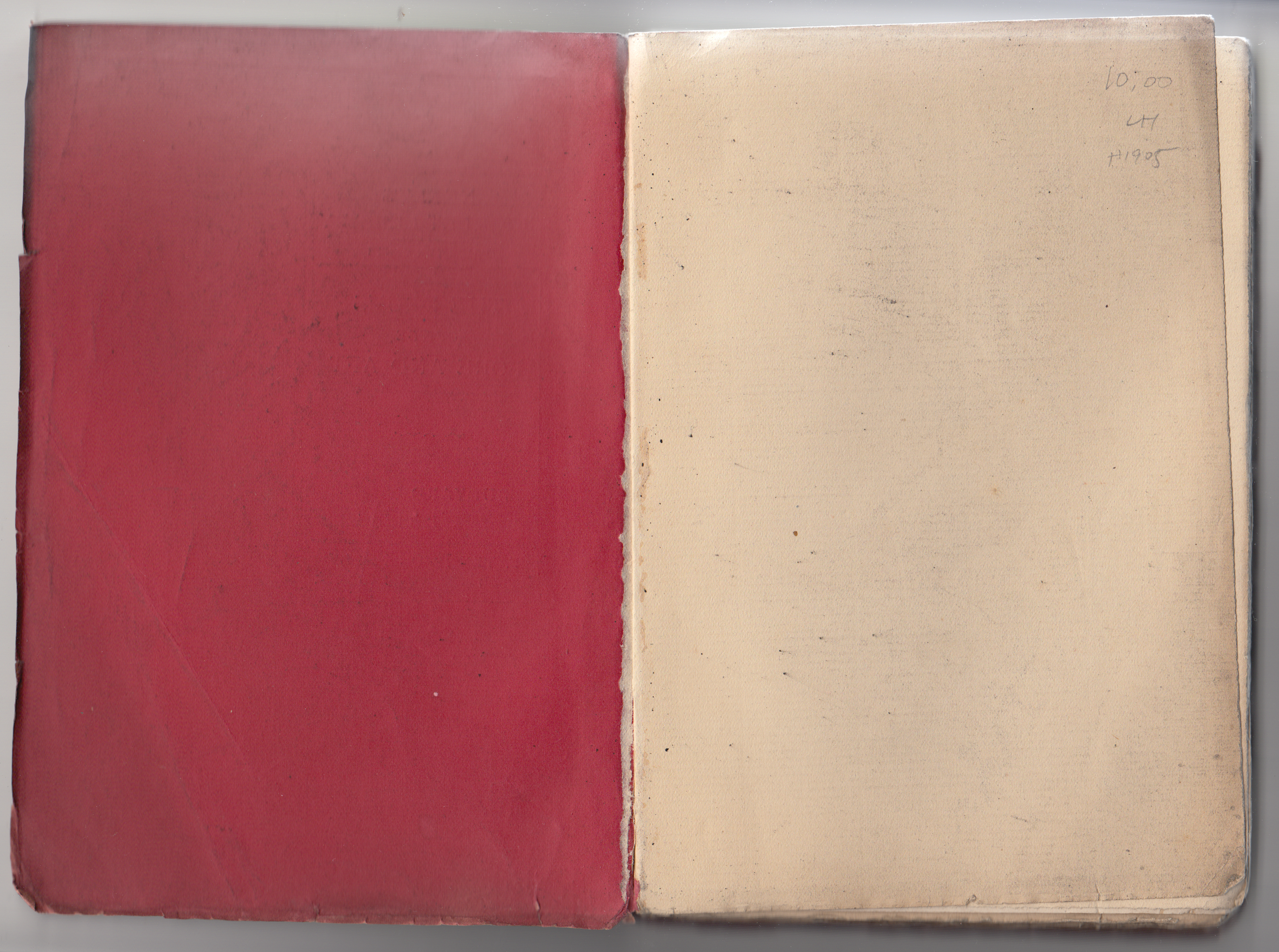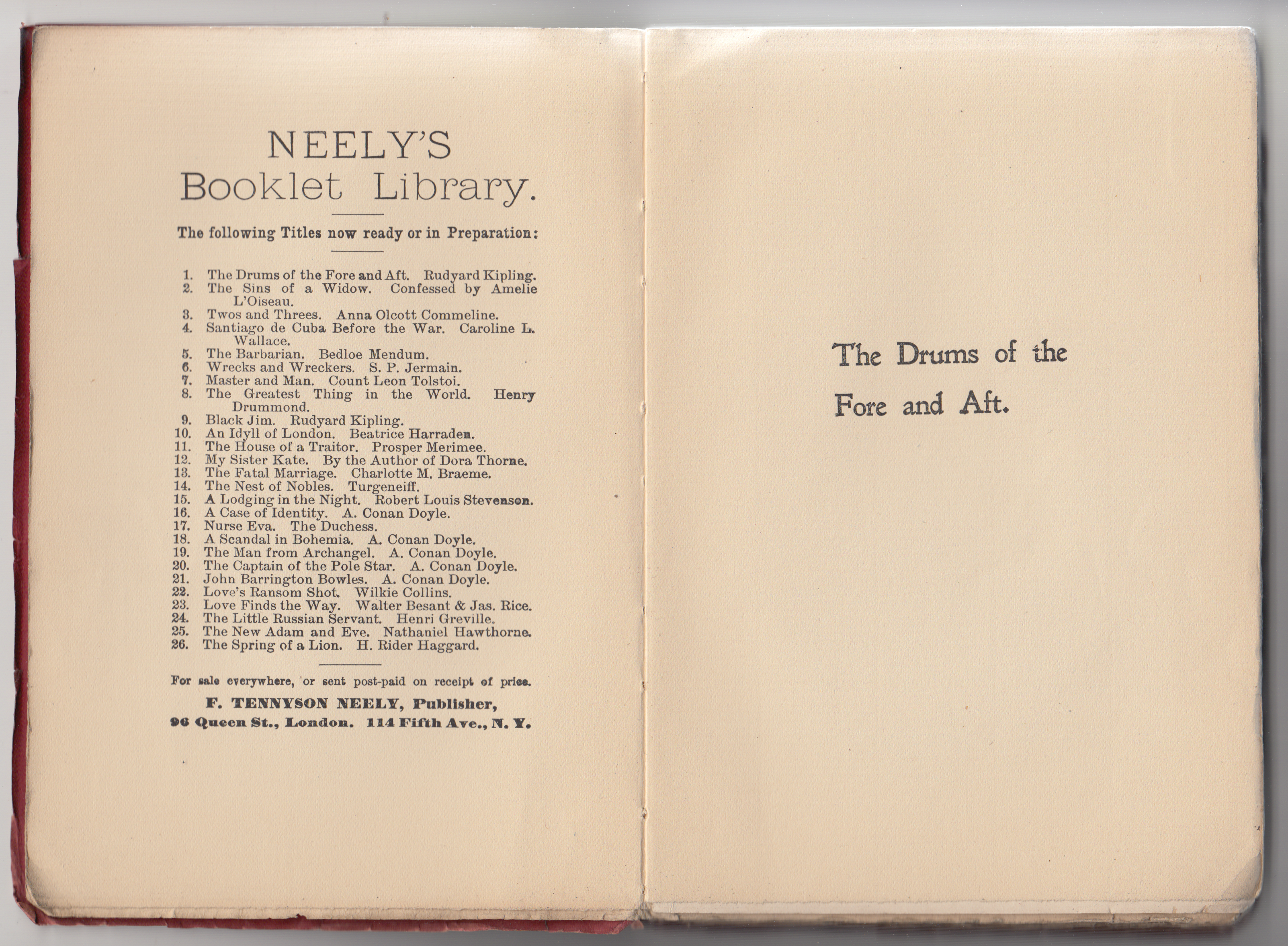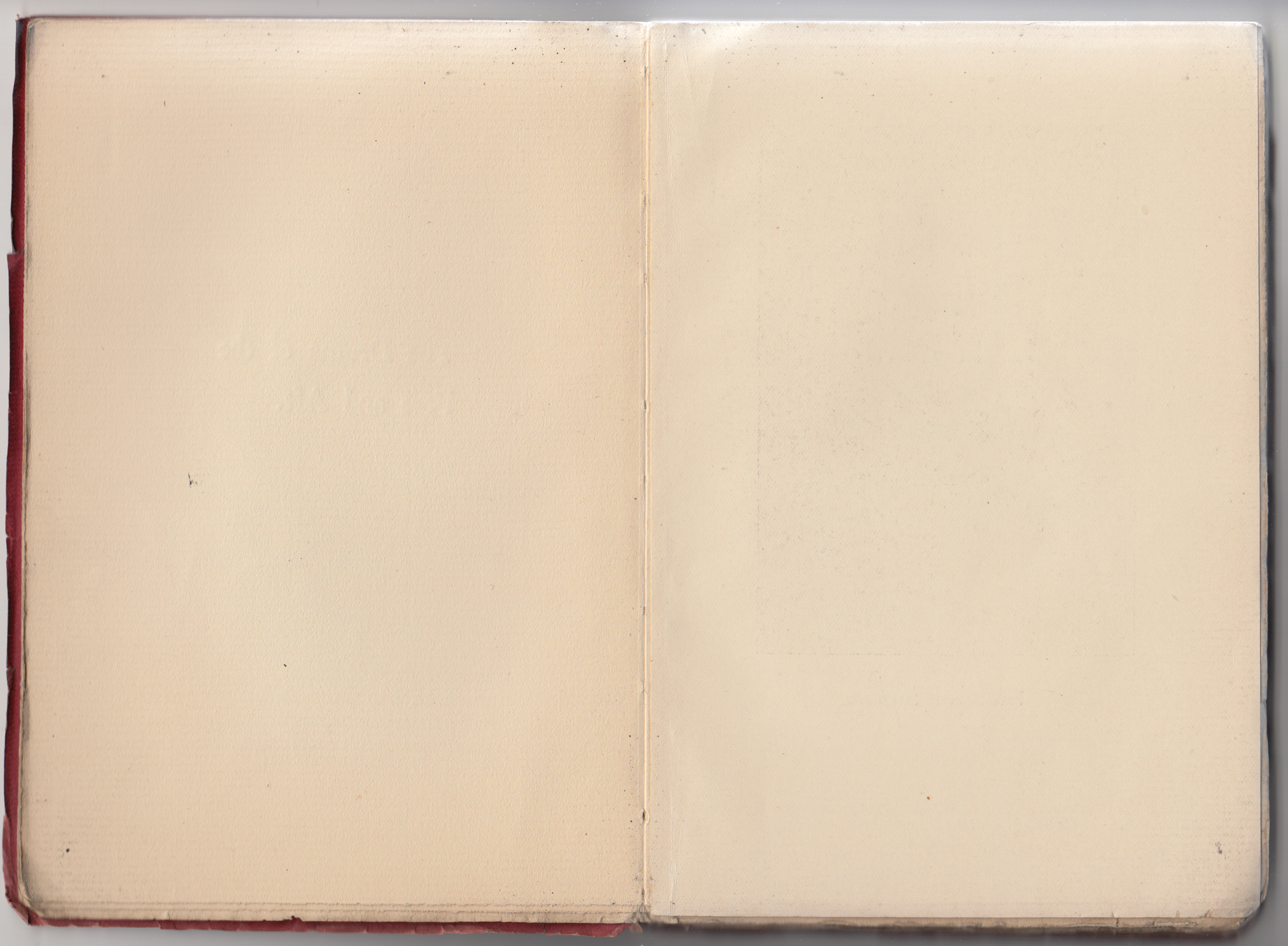F. Tennyson Neely (Chicago, US)
Series dates: (1898-1899)
Size: 5″ x 7.5″
Revised 10/31/2024
F. Tennyson Neely was an interesting character with a short but notable impact on turn-of-the-century publishing. Born outside of Tallahassee, FL (variously in Quincy, FL or Mt. Pleasant, FL) on Sept. 10, 1863, to an itinerant minister, the family moved to Alabama and eventually to Indiana, where Neely attended Indiana University.
After a failed attempt to purchase the De Moines, Iowa Leader, Neely established his own publishing firm at 323 Dearborn St. in Chicago in 1888, which he named after himself. “In 1891 the company moved to 232-234 Fifth Avenue, Chicago, and opened a New York branch at 114 Fifth Avenue. A London branch was opened at 96 Queen Street in 1897.” “Neely claimed to be producing six million copies of books each year and publishing, on average, a book a day” at his peak.” (source)
I have found some evidence of Neely’s books in the UK. A few notices appear in the London Times (in lists of new books) but no advertisements. A dozen or so cloth-bound Neely publications appear on AbeBooks.com (used books) with dates ranging from 1895 to 1901. But I’ve only seen Neely paperback titles in US dollars (or cents).
 In 1894 Neely arranged to publish U.S. editions of the “scandalous” translations of Emile Zola, originally published by Henry Vizetelly in the UK. These translations had landed Vizetelly in jail, and his publishing firm went bankrupt. Zola titles with the Neely imprint appear from 1894-1903 in WorldCat.
In 1894 Neely arranged to publish U.S. editions of the “scandalous” translations of Emile Zola, originally published by Henry Vizetelly in the UK. These translations had landed Vizetelly in jail, and his publishing firm went bankrupt. Zola titles with the Neely imprint appear from 1894-1903 in WorldCat.
Neely seems to have had an interest in publishing controversial and, in some cases, cutting-edge literature (such as early science fiction and horror). Given his history, this was probably a desire to generate controversy and sell more books. Neely’s more important published works include Robert Chambers’ horror classic The King in Yellow (1895) and books by E. Phillips Oppenheim, Anthony Hope, Jules Verne, and Richard Henry Savage. The Chambers’ title, in particular, has a significant value to modern collectors. Neely became embroiled in a lawsuit by Savage in 1896 which was settled a year later and may have put Neely in a precarious financial situation.
Economic troubles emerged in the U.S. in 1898, as Neely advertised “nationwide for agents” and promoted “via mail order the sale of branded libraries of cheap books.” (source) This explosion of cheap reprint series includes the series covered on this page – Neely’s Booklet Library, (10¢, paper) – as well as those advertised in a catalog in the back of the Booklet Library title: Neely’s Continental Library (50¢, paper), Neely’s Anglo-American Library (50¢, cloth), Neely’s Imperial Library (25¢, paper), Neely’s Prismatic Library (50¢, cloth), Neely’s Universal Library (25¢, paper), Neely’s Popular Library (25¢, paper), Neely’s Choice Library (50¢, paper), Neely’s and Neely Tourist Library (25¢, paper).
Many advertisements for Neely’s series (and other books) appear in 1899. The one below, from The Bookseller (June 1, 1899, p. 225), is for the Booklet’s series and indicates a 7¢ per title wholesale price. This advertisement includes titles that had not been released (June 20-14), indicating a regular emission of titles from the firm in this era.
In 1899 Neely’s firm went bankrupt, revealing a significant number of accounting irregularities and general malfeasance (including assigning copyright on his author’s books to himself). Attempts to hide some of his assets (including 49 bicycles [!]) were frowned upon by the courts. Neely reestablished his publishing firm in 1901 but was bankrupt again in 1903. Neely then headed west and was involved in mining and lecturing (political and geographical topics). In 1911 Neely was arrested for his role in a massive Ponzi scheme organized by Jared Flagg. He agreed to testify against Flagg and was released from jail soon after. A life of lecturing interspersed with involvement in sketchy schemes continued through the rest of Neely’s life, which ended in Philadelphia in 1941. (source)
Neely’s Booklet Library was at the lowest price point (10¢) of his many series issued in the late 1800s. This series is an example of a above-average “dime novel.” The books are printed on good paper, the binding is sewn (rather than glued), and they are generally well-designed. In many ways, they resemble the Tauchnitz Editions, which were paperbound, but intended to be of high enough quality to be bound in cloth by their owners.
The aesthetic attractiveness of the series titles hides the fact that these books may have been issued without their author’s consent, which was common at this time. Kipling and Doyle, in particular, were pirated repeatedly. In addition, these pirated editions were often based on other pirated editions, which included numerous errors. These issues (as they relate to Neely and other publishers) are discussed by Donald Redmond in Sherlock Holmes Among the Pirates: Copyright and Conan Doyle in America 1890-1930 (1990).
A list of the titles in Neely’s Booklet Library. The 26 titles listed in the book (scans shown further below) seem to all have been issued, although some do not appear in WorldCat. That may be because a title consisted of a few short stories from an author whose work was already in most libraries. I’ve included dates from WorldCat and other sources. A few of the early titles (#1, #3, #4) have 1898 dates, suggesting a few titles were issued in 1898 as Neely’s barrage of series was announced to the world. A few of these early titles have both 1898 and 1899 dates which indicate reprints of a few of the earlier titles.
1. The Drums of the Fore and Aft, by Rudyard Kipling (1898, 1899)
2. The Sins of a Widow, Confessed by Amelie L’Oiseau (1899)
3. Twos and Threes and Other Stories, by Anna Olcott Commelin (1898, 1899)
4. Santiago de Cuba Before the War, by Caroline L. Wallace (1898)
5. The Barbarian and Other Stories, by Bedloe Mendum (1899)
6. Wrecks and Wreckers: A Tragedy and a Mystery, by S.P. Jermain (Sylvanus Pierson) (1899)
7. Master and Man, by Count Leon Tolstoi (1899)
8. The Greatest Thing in the World, by Henry Drummond (1900)
*9. Black Jim, by Rudyard Kipling (1899) (source: United States Catalog, Books in Print, 1899)
10. An Idyll of London, by Beatrice Harraden (1899)
11. The House of a Traitor, by Prosper Merimee (1899)
*12. My Sister Kate. Bertha M. Clay, Pseudonym of Charlotte M. Brame (1899) (Source, Abebooks.com)
*13. The Fatal Marriage, by Charlotte M. Braeme (source: United States Catalog, Books in Print, 1900)
14. The Nest of Nobles, by Turgeneiff (Ivan Sergeevich Turgenev) (1899)
15. A Lodging in the Night, by Robert Louis Stevenson (1899)
*16. A Case of Identity, by A. Conan Doyle (1899) (Source: The Arthur Conan Doyle Encyclopedia)
17. Nurse Eva, by The Duchess (1899)
*18. A Scandal in Bohemia, by A. Conan Doyle (1899) (Source: The Arthur Conan Doyle Encyclopedia)
19. The Man from Archangel, by A. Conan Doyle (1899)
20. The Captain of the Pole Star, by A. Conan Doyle (1899)
*21. John Barrington Bowles, by A. Conan Doyle (1899)
*22. Love’s Ransom Shot, by Wilkie Collins (1899)
*23. Love Finds the Way, by Walter Besant & James Rice (1899)
24. The Little Russian Servant, by Henry Gréville (1899)
25. The New Adam and Eve, by Nathaniel Hawthorne (1899)
26. The Spring of a Lion, by H. Rider Haggard (1899)
*Not in WorldCat
A copy of Out of Nazareth, by Charles R. Hardy, is listed as #10 in Neely’s Booklet Library in WorldCat with an 1899 date and London imprint. This same book is also listed as #10 in Neely’s Author’s Library in another entry. I’m going to assume the record indicating this title was in the Booklet Library is in error, and that it is indeed #10 in the Author’s Library.
The paper covers of series titles have an unusual design (a bit like writhing tape worm pasta) which, in this case, are printed on heavy red paper. I’ve also seen purple ink on cream paper. The spine includes (top to bottom): 10 CTS, then “Neely’s Booklet Library, No. 1”, the title and author, and the printer with London and New York indicated. A framed rectangle on the front cover includes the series name, price (10¢), title, author, and publisher. The front and back of the cover repeat.
The red paper covers are glued to the book’s pages, which are sewn and glued to the cover.
Two more blank pages:
A list of the 26 titles in the Booklet Library faces the half-title page:
A pair of blank pages follows:
A portrait of Kipling faces the title page:
No dates or copyright is indicated on the verso of the title page. As noted above, this is probably a pirated book.
The rear of the book contains what is probably a relatively comprehensive list of Neely titles, including those in the various series announced in 1898. Prices and other details of the books are included. Right-click to open and enlarge each image below.
 |
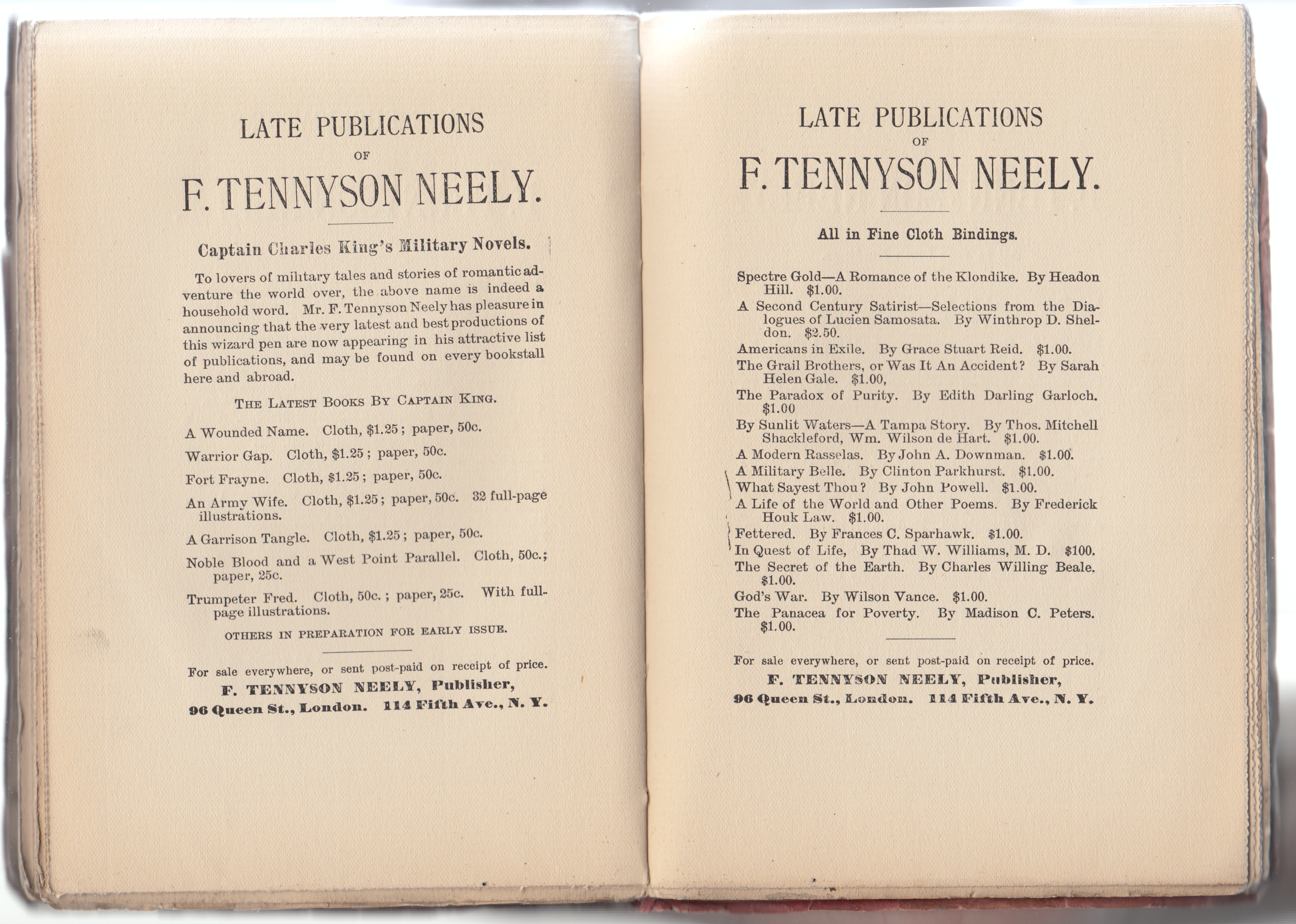 |
 |
 |
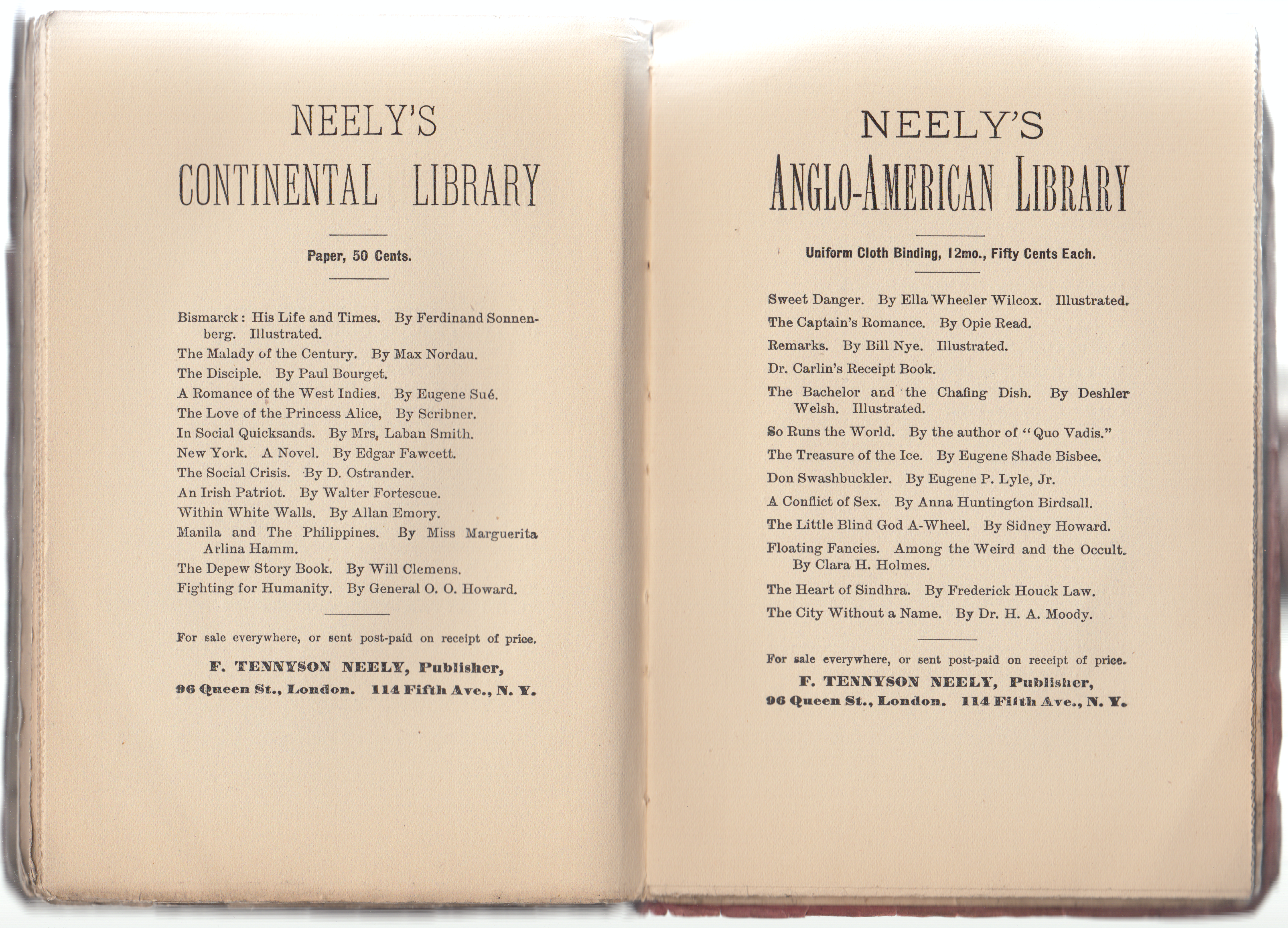 |
 |
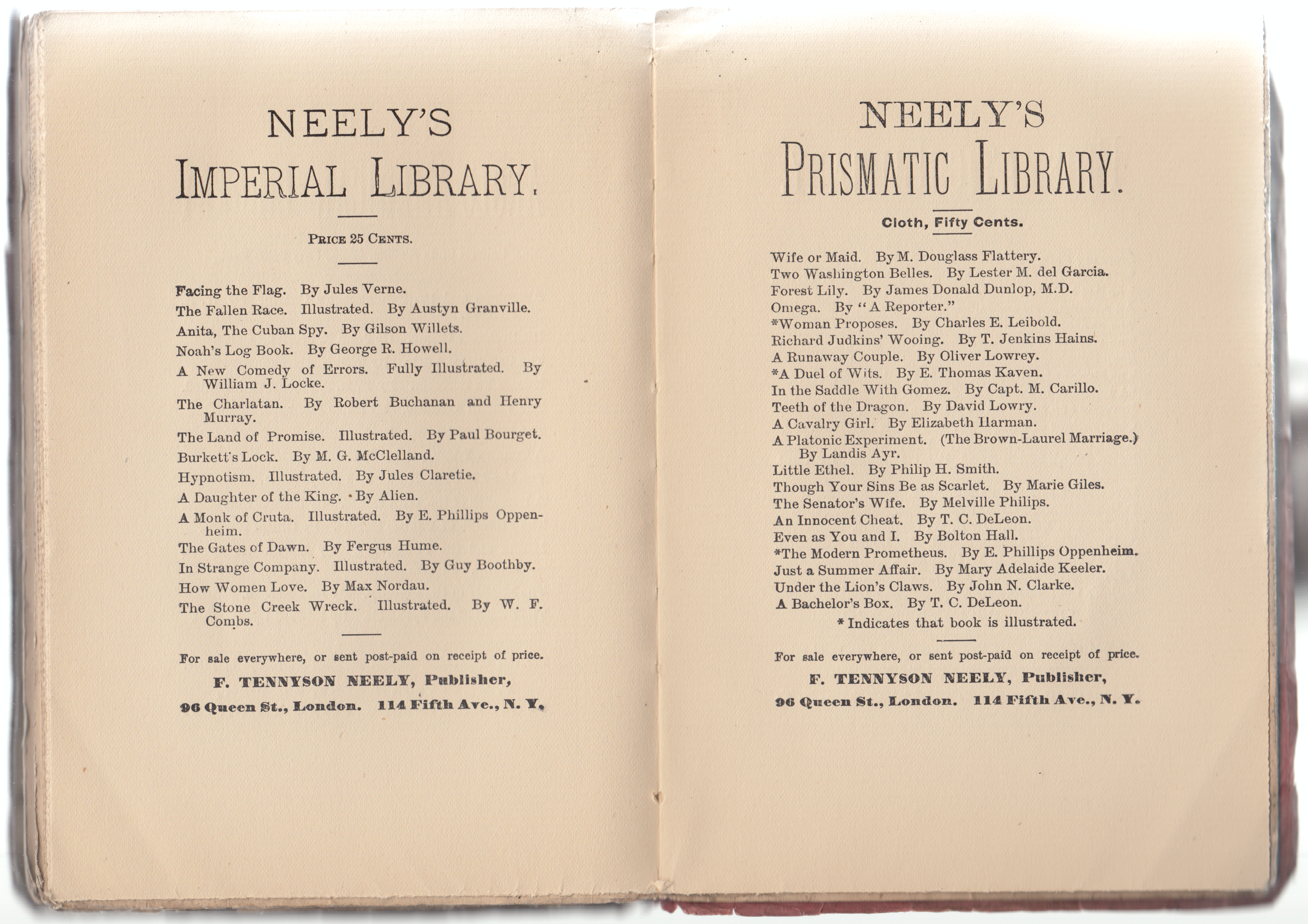 |
 |
 |
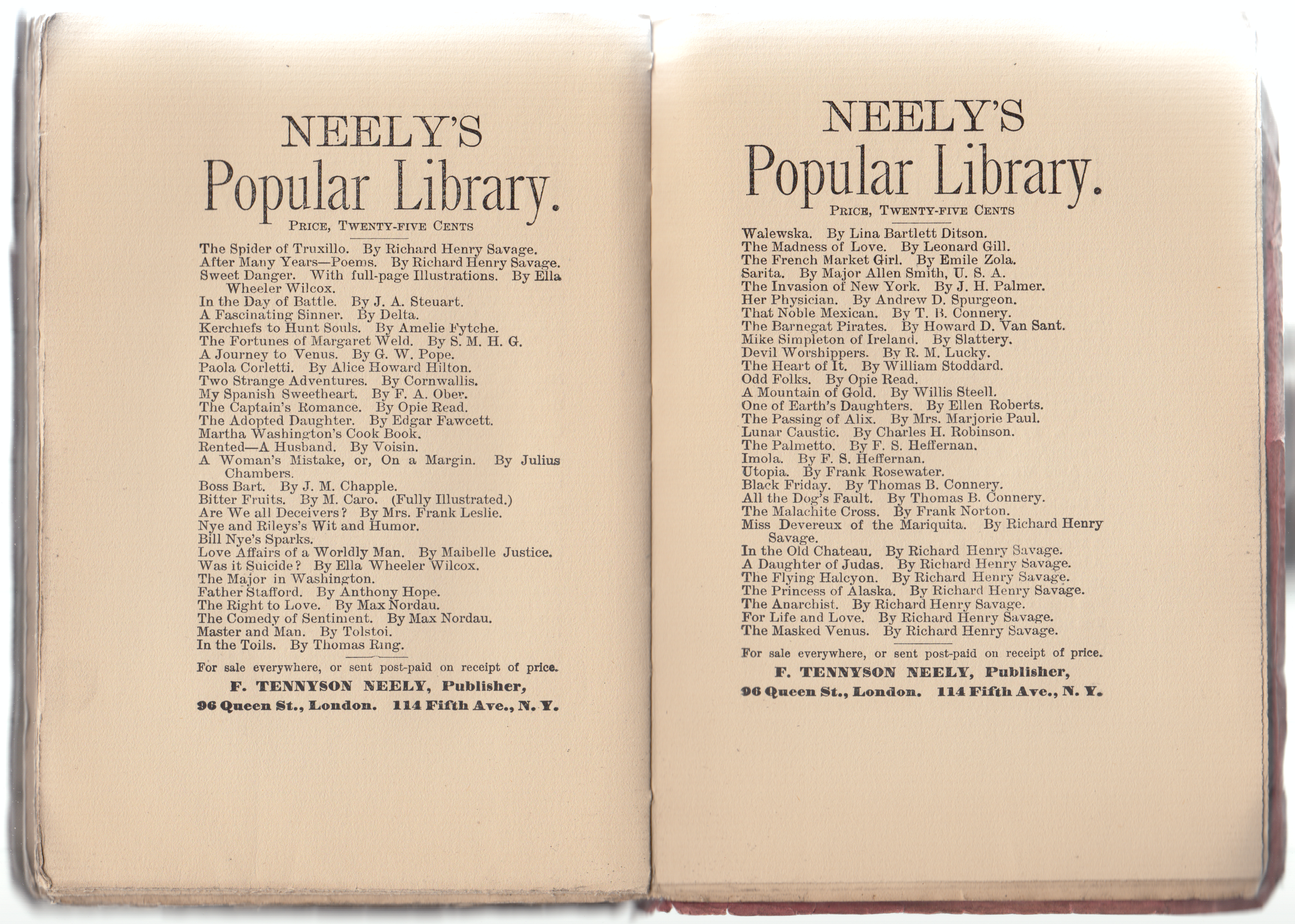 |
 |
 |



